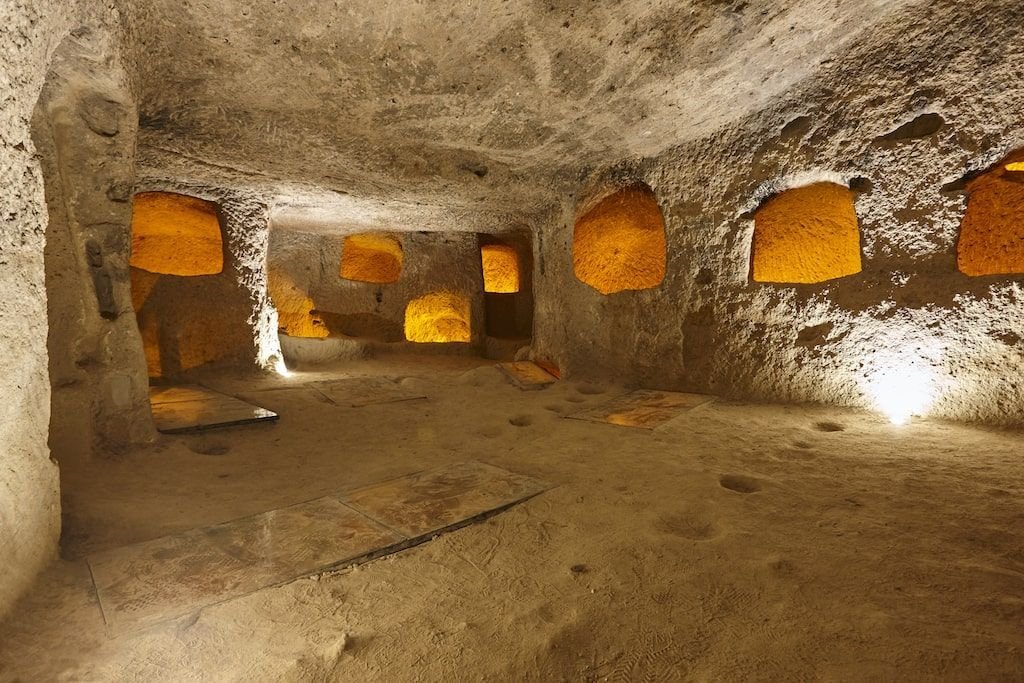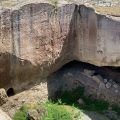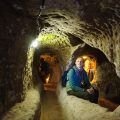Deep beneath the sun-drenched landscapes of Cappadocia in Turkey lies a hidden marvel that has intrigued scholars and enchanted travelers for centuries—the Kaymakli Underground City. An astonishing feat of ancient ingenuity and resilience, this subterranean labyrinth offers a glimpse into a world far removed from the bustling surface above. For travel enthusiasts, cultural explorers, and history buffs alike, a visit to Kaymakli is nothing short of a time-traveling adventure.
A Journey Through Time The Origins of Kaymakli
Kaymakli Underground City isn’t just a marvel of human craftsmanship; it’s a testament to survival and adaptation. Carved meticulously from the region’s soft volcanic tuff rock, the city’s origins trace back to the Hittites in the 8th century BC. These ancient Anatolian people used the labyrinthine tunnels as a refuge during wartime, showcasing their strategic foresight and architectural prowess.
Digging through volcanic rock with rudimentary tools like picks and chisels required immense labor and time. Yet, the Hittites’ determination bore fruit in the form of a multi-layered underground sanctuary. Their vision laid the groundwork for what would become a critical refuge for countless generations.
The carved-out spaces provided not just safety but also a stable environment where inhabitants could store food, livestock, and supplies. This self-sufficient underground city became a lifeline during periods of conflict, ensuring the survival of its occupants against external threats.
The Christian Refuge A Sanctuary of Faith
Fast forward a few centuries, and Kaymakli became more than just an architectural wonder—it transformed into a spiritual sanctuary. During the early centuries AD, Cappadocia emerged as a significant hub for Christianity. Amidst the turbulence of religious persecution, early Christians sought refuge within Kaymakli’s protective confines.
The extensive network of tunnels and chambers allowed them to practice their faith discreetly, away from the prying eyes of hostile forces. The underground city became a haven, where families and communities could gather, worship, and live without fear.
Christian symbols and artifacts discovered in Kaymakli provide glimpses into this period of its history. These remnants underscore the city’s role in preserving a way of life and belief system under threat, highlighting its importance as both a cultural and religious landmark.
Architectural Brilliance Design and Engineering Feats
The architectural brilliance of Kaymakli is a testament to the ingenuity of its creators. The city spans several levels, each intricately designed to accommodate various functions. From living quarters and kitchens to stables and storage areas, every space was purposefully crafted to meet the needs of its inhabitants.
Ventilation shafts and waste disposal systems showcase the advanced engineering skills employed by those who built the city. These features ensured a continuous supply of fresh air and hygiene, even deep underground, making the city habitable for extended periods.
Visitors today can marvel at the complexity of these systems, which speak to a level of sophistication that belied the era’s limited technological resources. The thoughtful design of Kaymakli is a testament to the tenacity and resourcefulness of its ancient inhabitants.
A Safe Haven Throughout History
Beyond the Hittites and early Christians, Kaymakli Underground City played a crucial role as a refuge throughout history. Various groups sought its protection during times of war and conflict, finding solace within its fortified walls and hidden chambers.
During the Byzantine era, Kaymakli served as a bulwark against invasions, providing a strategic advantage through its secretive layout. Its use as a storage facility for food and supplies added further layers of utility, ensuring the survival of its residents against external threats.
This enduring legacy of Kaymakli as a safe haven underscores its historical importance. It stands as a living chronicle of human resilience, adaptability, and the ceaseless quest for survival amid adversity.
Modern Exploration and Discovery A Window to the Past
Today, Kaymakli Underground City is a UNESCO World Heritage Site, drawing visitors from around the globe eager to explore its ancient corridors. The experience offers a unique blend of adventure and education, as travelers weave through the city’s maze-like passages, uncovering stories etched into its walls.
Guided tours provide insights into the city’s rich history and offer visitors a chance to marvel at its architectural wonders firsthand. The city’s preservation as a cultural landmark allows for continued exploration and discovery, offering valuable lessons from the past.
For history buffs, the opportunity to walk through Kaymakli’s storied tunnels is akin to stepping back in time. Each chamber tells a tale of perseverance and innovation, inviting visitors to immerse themselves in a world where history comes alive.
The Cultural Significance of Kaymakli
Beyond its architectural and historical marvels, Kaymakli holds tremendous cultural significance. The city stands as a symbol of unity and resilience across generations, transcending religious and cultural boundaries. Its role as a sanctuary for persecuted Christians highlights its importance as a site of religious tolerance and coexistence.
The city’s continued relevance is a reminder of the shared human experience, where people have sought shelter and community in times of need. As a cultural touchstone, Kaymakli offers profound insights into the human spirit and our collective history.
Today, visitors can connect with this rich cultural heritage, gaining a deeper appreciation for the diverse tapestry of stories that Kaymakli embodies. The city’s preservation ensures that its legacy endures, inspiring future generations to explore, learn, and reflect.
Practical Tips for Visiting Kaymakli
For those planning a visit to Kaymakli, preparation is key to maximizing the experience. Comfortable footwear is a must, as the city’s uneven surfaces and narrow corridors require careful navigation. Flashlights can enhance visibility in some dimly lit areas, ensuring a safe and enjoyable exploration.
Guided tours provide valuable context and insights into the city’s history, making them a worthwhile addition to any visit. Local guides offer firsthand knowledge and stories, enriching the experience with their expertise and passion.
Visitors should also consider exploring nearby attractions within Cappadocia, known for its unique geological formations and breathtaking landscapes. The region offers a wealth of experiences, from hot air balloon rides to traditional Anatolian cuisine, making it a destination worth savoring.
Conclusion Kaymakli’s Enduring Legacy
Kaymakli Underground City is more than just a historical site—it’s a testament to the enduring strength and creativity of humanity. Its complex network of tunnels and chambers tells a story of survival, innovation, and community that resonates across time.
For travel enthusiasts, cultural explorers, and history buffs, a visit to Kaymakli offers an unforgettable experience that transcends the ordinary. It invites us to connect with the past, learn from its lessons, and celebrate the resilience that defines the human spirit.
As you plan your next adventure to Cappadocia, consider adding Kaymakli to your itinerary. Explore its ancient corridors, uncover its hidden stories, and immerse yourself in a world where history and culture intertwine.




